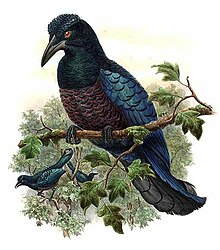
The crested partridge also known as the crested wood partridge, roul-roul, red-crowned wood partridge, green wood quail or green wood partridge is a gamebird in the pheasant family Phasianidae of the order Galliformes, gallinaceous birds. It is the only member of the genus Rollulus.
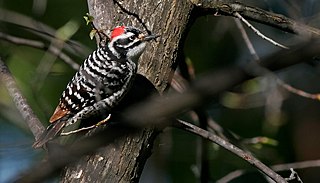
Nuttall's woodpecker is a species of woodpecker named after naturalist Thomas Nuttall in 1843. They are found in oak woodlands of California and are similar to the ladder-backed woodpecker in both genetics and appearance.

The square-tailed kite is a medium-sized bird of prey in the family Accipitridae, which also includes many other diurnal raptors such as kites, eagles and harriers.
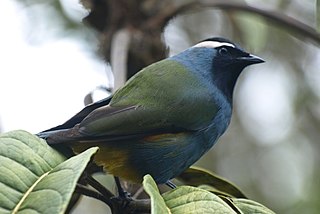
The painted berrypeckers, Paramythiidae, are a very small bird family restricted to the mountain forests of New Guinea. The family comprises three species in two genera: the tit berrypecker in Oreocharis, and the eastern crested berrypecker and western crested berrypecker in Paramythia. These are colourful medium-sized birds which feed on fruit and some insects. These species were formerly included in the Dicaeidae, but DNA–DNA hybridization studies showed these species were related to each other but distinct from the flowerpeckers. Some sources group painted berrypeckers as two genera belonging to the berrypecker family Melanocharitidae.

The blue bird-of-paradise is a large species of bird-of-paradise. It is the only species in the genus Paradisornis, but was previously included in the genus Paradisaea.

The magnificent bird-of-paradise is a species of bird-of-paradise. The magnificent bird-of-paradise is evaluated as Least Concern on the IUCN Red List of Threatened Species. They are listed in Appendix II of CITES.
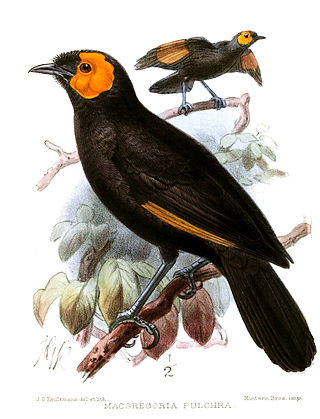
MacGregor's honeyeater, also known as giant wattled honeyeater, MacGregor's giant honeyeater, MacGregor's bird of paradise, and ochre-winged honeyeater, is a large black crow-like bird with large orange-yellow eye-wattles and black-tipped, ochre primary wing feathers. The sexes are similar, with the male being slightly larger than the female. It is the only member of the genus Macgregoria.
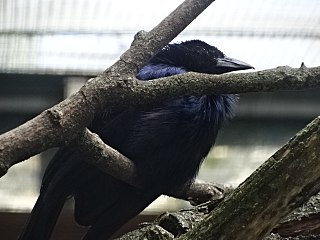
The trumpet manucode is a species of bird in the family Paradisaeidae.
The Jobi manucode is a species of crow-like bird-of-paradise.

The glossy-mantled manucode is a species of bird-of-paradise.

The crinkle-collared manucode is a species of bird-of-paradise.

The crested guineafowl are a group of three species and members of the Numididae, the guineafowl bird family. They are found in open forest, woodland and forest-savanna mosaics in sub-Saharan Africa.

The Trobriand Islands rain forests are a tropical moist broadleaf forest ecoregion of southeastern Papua New Guinea.

The white-bibbed fruit dove is a species of bird in the family Columbidae.

The pied cuckoo-dove is a species of bird in the pigeon family, Columbidae. First described by English zoologist Philip Sclater in 1877, it is endemic to the Bismarck Archipelago, where it mainly inhabits lowland and hill forests at elevations of up to 1,000 m (3,300 ft). It is a large, distinctive pigeon, with a length of 40–46 cm (16–18 in) and a weight of 279–325 g (9.8–11.5 oz). Adults are mainly black and white. The heads and underparts are whitish, while the wings, tails, and upperparts are black. Both sexes look alike. Juveniles are mainly sooty-grey in colour.

The loggerhead kingbird is a species of sub-oscine passerine bird belonging to the family Tyrannidae, the tyrant flycatchers. This species is found in wooded habitats in the islands of the northern Caribbean, with records of vagrants from Florida.

The Aldabra fody is a passerine bird in the family Ploceidae. It is endemic to Aldabra, an atoll northwest of Madagascar, part of Seychelles. Regarded as conspecific with the Comoros fody in the past, it is now recognized as a distinct species by the International Union for the Conservation of Nature (IUCN). Both sexes are yellow in color across much of the body, with breeding males orange-scarlet on the head and neck. The species has a large and powerful bill, used to compete with other birds of Aldabra for food. Nesting occurs over several months, often in introduced coconut palms and Casuarina trees. The Aldabra fody is considered endangered by the IUCN, threatened by predation of nests and drought. Hybridization with the related Madagascar fody has occurred in the past, but is not currently considered a danger to the species.

The Obi paradise-crow is a species of paradise-crow in the family Paradiseaidae along with the birds-of-paradise. This bird was split from its congener, the Halmahera paradise-crow (L. pyrrhopterus) in 2016. The species was first described and named by Heinrich Agathon Bernstein in 1865.

The Papuan eclectus, red-sided eclectus, or New Guinea eclectus is a parrot species which is native to New Guinea. Larger than the Moluccan eclectus, the green plumage of the male only has a slight yellow tinge and the tail is tipped with a half-inch yellow band. The central tail feathers are green and lateral ones blue and green. It is widely distributed from Kai Islands and western islands of the West Papua province in the west, across the island of New Guinea to the Trobriands, D'Entrecasteaux Islands, Louisiade Archipelago, Bismarck Archipelago, and Solomon Islands to the east, and south to the northern Cape York Peninsula of Australia. It has also been introduced to the Goram Islands, Indonesia.
